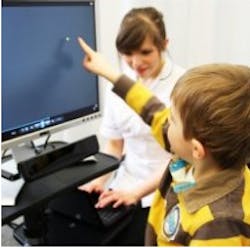Scottish university spin-out launches visual field analyzer
An Edinburgh University spin-out has developed what it claims is the world’s first visual field analyzer for patient groups whose visual field was previously impossible to test, including young children and vulnerable adults.
Existing visual field testing instruments depend on the patient’s complete understanding, cooperation and feedback and involve keeping the patient’s head still, staring at a fixed point for several minutes.
The i2eye Diagnostics (Edinburgh, UK) system, on the other hand, harnesses the patient’s natural reactions to movement and light to analyze their visual field without any need for them to keep still, understand the test or give feedback to the tester. Visual field testing can now be performed on very young children as well as many elderly patients and other groups who could not previously be tested.
The technology behind the Saccadic Vector Optokinetic Perimetry (SVOP) visual field analyzer was developed over five years by a clinical research team at the University of Edinburgh consisting of ophthalmologists, neurologists and medical physicists and led by Robert Minns, Professor of Pediatric Neurology.
The system comprises a personal computer, display, and eye tracker to monitor gaze position when stimuli are presented to a patient. When the patient’s eye movement fixates on the stimuli, it can be detected and measured to produce a visual field plot.
“Our instrument is a generation ahead of anything else currently on the market and has enormous potential. One of its first applications is in the monitoring and clinical management of children with brain tumors, where it can aid the decision making process, potentially leading to a better outcome,” says Peter Estibeiro, i2Eye’s chief executive officer.
The SVOP instrument is scheduled for CE Marking in May 2012 and FDA Approval in the fourth quarter of 2012.
--by Dave Wilson, Senior Editor, Vision Systems Design
